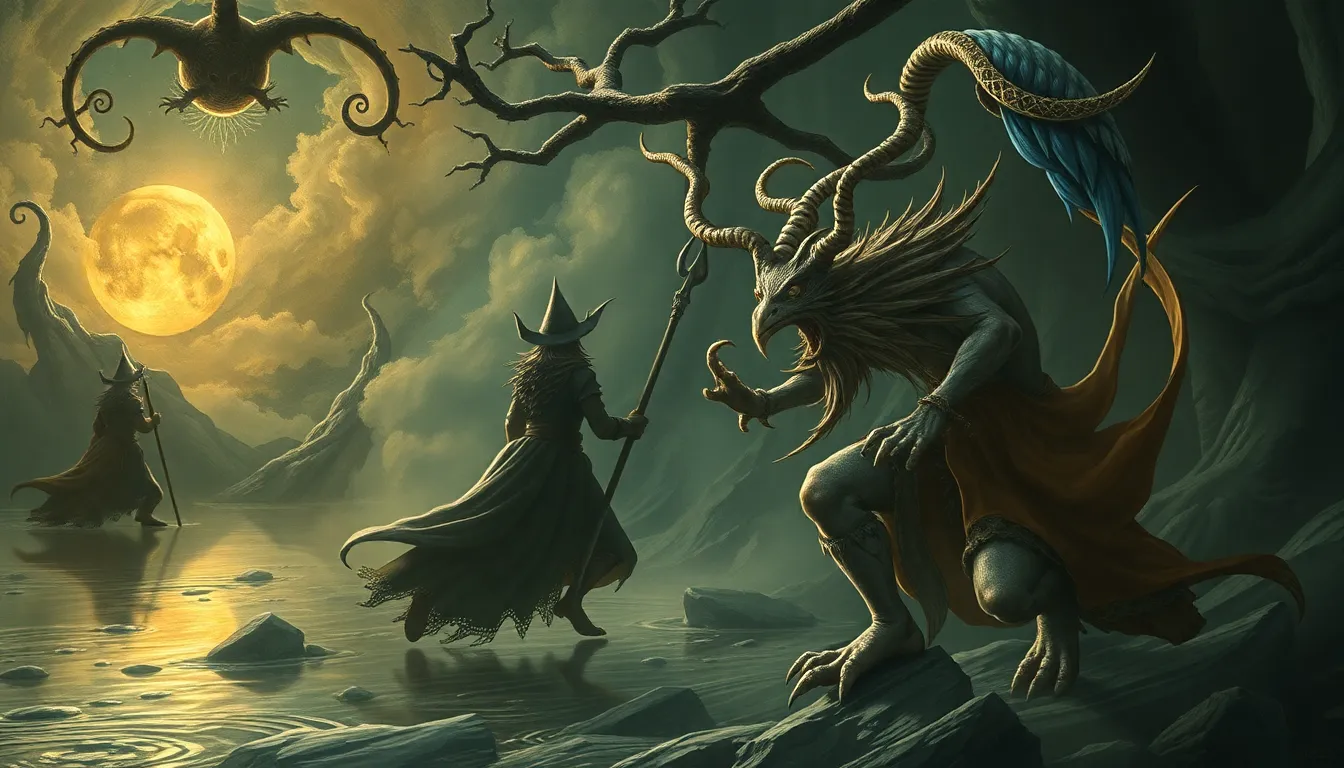The Underworld: A Mythical Realm of Fear and Fascination
I. Introduction to the Underworld
The concept of the Underworld has captivated human imagination across various cultures and epochs. Generally defined as a realm beneath the earth, it is often portrayed as a place where souls go after death. The significance of the Underworld varies widely, serving as an essential component of mythologies, spiritual beliefs, and cultural narratives. This article delves into the themes of fear and fascination that the Underworld evokes in human consciousness.
II. Historical Perspectives on the Underworld
Throughout history, different civilizations have conceived of the Underworld in unique ways, reflecting their cultural values and beliefs about life, death, and the afterlife.
A. Ancient civilizations and their interpretations
1. Mesopotamian beliefs
In ancient Mesopotamian culture, the Underworld, known as Kur, was viewed as a dreary and shadowy place. Souls of the deceased were believed to descend into this realm, where they would exist in a state of gloom, cut off from the joys of the living. The Mesopotamians had rituals aimed at honoring the dead, hoping to appease the spirits and ensure a peaceful afterlife.
2. Egyptian afterlife concepts
The ancient Egyptians had a more complex view of the afterlife, with the Underworld known as Duat. This realm was depicted as a journey filled with trials, where the deceased would be judged by Osiris, the god of the afterlife. Successful navigation through Duat allowed the soul to reach the Field of Reeds, a paradise-like existence.
B. The Underworld in Greek mythology
1. Hades and its significance
In Greek mythology, Hades was both the name of the god of the Underworld and the realm itself. It was seen as a place for all souls, regardless of their moral standing in life. Hades was neither a paradise nor a place of punishment, embodying a more neutral perspective on death.
2. The concept of the River Styx
The River Styx, a prominent feature of Hades, served as a boundary between the living and the dead. Souls were transported across the river by Charon, the ferryman, who required payment in the form of an obol, a small coin placed in the mouth of the deceased. This practice highlighted the significance of proper burial rites in ancient Greek culture.
III. Comparative Analysis of Underworlds Across Cultures
Examining the Underworld across various cultures reveals both similarities and differences in how societies conceptualize life after death.
A. The Underworld in Eastern mythologies
1. Yama in Hinduism
In Hinduism, Yama is the god of death and ruler of the Underworld, known as Naraka. Unlike the Greek Hades, Naraka is often depicted as a place of punishment for wrongdoers, where souls undergo purification before reincarnation. Hindu beliefs emphasize the cyclical nature of life and death, making the Underworld a temporary stop in the soul’s journey.
2. The Chinese Diyu
Diyu, or the Chinese Underworld, is a complex realm with multiple levels, each corresponding to different sins. Souls are judged by the Ten Kings, and those who have led virtuous lives are rewarded, while wrongdoers face various punishments. The Chinese perspective emphasizes moral accountability and the importance of ancestral veneration.
B. Indigenous beliefs and their unique Underworlds
1. Native American perspectives
Many Native American tribes have their unique beliefs about the Underworld. For instance, some view it as a place where ancestors reside, providing guidance to the living. The afterlife is often depicted as a continuation of life on earth, with a strong connection to nature and spirituality.
2. African tribal beliefs
In various African cultures, the Underworld is seen as a realm inhabited by ancestors. The living maintain a relationship with their ancestors through rituals and offerings, reinforcing the belief that the deceased continue to influence the living world. This connection emphasizes the cyclical nature of existence in many African belief systems.
IV. The Psychological Impact of the Underworld
The Underworld serves as a powerful symbol of humanity’s deep-seated fears and desires regarding death and the unknown.
A. Fear of death and the unknown
Death remains one of the greatest mysteries of human existence. The Underworld symbolizes this fear, representing a transition that is both inevitable and unknown. Different cultures have created narratives to cope with this fear, using the Underworld as a way to explain what happens after death.
B. The Underworld as a reflection of human fears and desires
By examining the Underworld, we can gain insight into human psychology. It reflects our desires for justice, redemption, and continuity of existence, while simultaneously embodying our fears of isolation and punishment. Through myths and stories, cultures explore these complex emotions, making the Underworld a rich subject for psychological exploration.
V. Symbolism and Imagery Associated with the Underworld
The Underworld is often depicted with powerful symbols that evoke a sense of darkness and mystery.
A. Common symbols (e.g., darkness, rivers, gates)
- Darkness: Represents the unknown and the fear associated with death.
- Rivers: Often symbolize the journey between life and death, as seen in the River Styx.
- Gates: Serve as thresholds between the living and the dead, marking the transition from one realm to another.
B. Artistic representations through history
Throughout history, artists have portrayed the Underworld in various forms, from ancient pottery depicting mythological scenes to modern interpretations in film and literature. These representations reflect society’s evolving understanding of death and the afterlife.
VI. The Underworld in Literature and Art
The Underworld has been a significant theme in classical and contemporary literature and art.
A. Classical literature and its influence
1. Virgil’s “Aeneid”
Virgil’s “Aeneid” offers a detailed vision of the Roman Underworld, emphasizing themes of destiny and divine judgment. The journey of Aeneas through the Underworld serves as a metaphor for the struggles of human existence.
2. Dante’s “Inferno”
Dante’s “Inferno” provides a vivid portrayal of the Underworld as a place of punishment. The structure of Hell in Dante’s work reflects the moral and ethical considerations of his time, influencing countless interpretations of the afterlife.
B. Modern interpretations in literature and visual arts
In contemporary literature and visual arts, the Underworld continues to inspire creativity. Authors and artists explore themes of death, loss, and redemption, using the Underworld as a backdrop for complex narratives that resonate with modern audiences.
VII. The Role of Deities and Spirits in the Underworld
Deities and spirits play crucial roles in the various interpretations of the Underworld across cultures.
A. Key figures across different mythologies
1. Charon, Persephone, and Hades
In Greek mythology, Charon is the ferryman of souls, while Persephone represents the seasonal cycle of life and death. Hades, as the ruler, oversees the realm of the dead, embodying the duality of life and death.
2. Anubis and Osiris
In Egyptian mythology, Anubis is the god of mummification and the protector of graves, while Osiris is the god of the afterlife and resurrection. Together, they symbolize the importance of preparation for the afterlife and the hope of rebirth.
B. The duality of benevolence and malevolence
The figures associated with the Underworld often embody both benevolent and malevolent traits. This duality reflects the complexities of human nature and the moral dimensions of life and death.
VIII. The Underworld in Contemporary Culture
In modern times, the Underworld has found its way into popular culture, influencing various mediums.
A. Cinematic portrayals and their impact on perception
Films often depict the Underworld as a place of adventure or horror, shaping public perception of death and the afterlife. These portrayals can reinforce or challenge traditional beliefs, prompting audiences to reflect on their own views.
B. Video games and their exploration of the Underworld theme
Video games frequently explore Underworld themes, allowing players to navigate realms of the dead, face challenges, and confront



